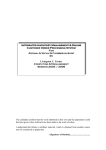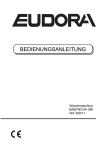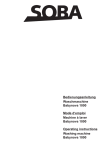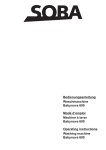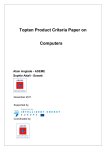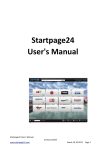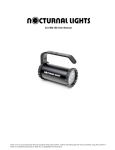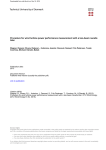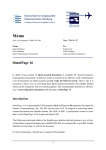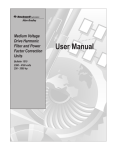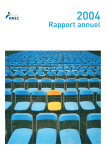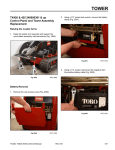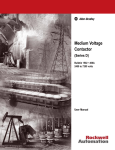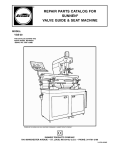Download consumer relevant eco-design and labelling requirements for
Transcript
CONSUMER RELEVANT ECO-DESIGN AND LABELLING REQUIREMENTS FOR HOUSEHOLD WASHING MACHINES Contact: Sylvia Maurer – [email protected] [email protected] Ref.: X/069/2008 - 27/11/08 ANEC-PT-2008-EuP-046final ANEC, the European Association for the Co-ordination of Consumer Representation in Standardisation Av. de Tervueren 32, box 27 – 1040 Brussels - +32 2 743 24 70 - www.anec.eu BEUC, the European Consumers’ Organisation 36 avenue de Tervueren, 1040 Bruxelles - +32 2 743 15 90 - www.beuc.eu Summary In the context of the implementation of the Eco-design of energy-using products, the European Commission is proposing eco-design and labelling requirements for washing machines (Lot 14).This paper outlines the main consumer relevant issues related to possible eco-design and labelling requirements for this category of products and recommends improvement options. In overall, we welcome that the Eco-design requirements address energy and water consumption but also address the washing performance of washing machines. However, we emphasise the need to base calculations for energy efficiency requirements on real life consumer behaviour and to improve consumer information on the environmental impacts of washing. We therefore ask to modify the calculation formula for the Energy Efficiency Index (EEI). We also call for a technical solution that would switch the washing machine automatically into standby after the end of the washing cycle and thereby avoiding unwanted energy losses from a “left-on mode”. Moreover, we argue that benchmarks should indicate best available technologies for small 3 kg machines with regard to the related noise level and washing performance. Finally we strongly criticise the proposed layout of the Energy Label as it introduces a double scale numbers and letters which would be far too confusing for consumers. We urge the Commission and Member States to keep the layout of the well-known A-G label. 2 ANEC, the European Association for the Co-ordination of Consumer Representation in Standardisation Av. de Tervueren 32, box 27 – 1040 Brussels - +32 2 743 24 70 - www.anec.eu BEUC, the European Consumers’ Organisation 36 avenue de Tervueren, 1040 Bruxelles - +32 2 743 15 90 - www.beuc.eu Introduction This paper outlines the main consumer relevant issues related to possible ecodesign and labelling requirements for washing machines (Lot 14) and recommends improvement options. Comments are based on the Working Documents of the Commission 1 which were provided to stakeholders on 7 November 20082 . 1. General remarks The stock of washing machines in consumers’ homes has continuously grown since the 1950s, with up to 90% of households now owning a washing machine. This corresponds to 167 million washing machines in the EU-27. As 40 million of the existing washing machines in households are older than 10 years, it is likely that a considerable number of washing machines will need to be replaced soon 3 . Although the energy efficiency of washing machines has improved following the introduction of the EU Energy Labelling Scheme, the current trend towards larger machines with higher load capacities is likely to outweigh the energy use reduction achieved so far. Whereas the average load capacity was 4.8 kg in the year 1997, the capacity grew to almost 5.4 kg in 2005. Today, models of 4 to 5 kg are substituted by models of 5 to 6 kg and new models with a capacity of 7 kg or more are introduced into the market 4 . It is questionable whether these higher load capacities are for the benefit of consumers. In fact, not all consumers wash at full load, thus unnecessarily increasing the use of water and electricity. In order to ensure that resource consumption will continue to decrease, we stress the need for ambitious eco-design and labelling requirements. 2. Eco-design requirements on energy efficiency The working document foresees requirements of washing machines: a 3-staged approach for the eco-design 1 Working Document on a possible Commission Regulation implementing Directive 2005/32/EC with regard to household washing machines and Working Document on a possible Commission Directive implementing Council Directive 92/75/EC with regard to household washing machines. 2 Based on the working documents for possible eco-design requirements for household washing machines the Commission will prepare a draft Implementing Measure (IM). This draft IM will be submitted for voting to the Regulatory Committee of the Eco-design Directive. After the vote of the Regulatory Committee the European Parliament has a right of scrutiny. 3 See Preparatory Study task 2 report. 4 The Dutch Consumentenbond tested 9 new models. A 5 kg machine was the one with the smallest capacity in the test and a 7 kg machine had the highest rated capacity. See “Consumentengids” March 2008, p. 30-33. Stiftung Warentest tested 13 models recently. In this test also a 5 kg machine was one with the smallest rated capacity and a 7.5 kg machine had the highest rated capacity. See: test 10/2008, pp. 58-63. ANEC, the European Association for the Co-ordination of Consumer Representation in Standardisation Av. de Tervueren 32, box 27 – 1040 Brussels - +32 2 743 24 70 - www.anec.eu BEUC, the European Consumers’ Organisation 36 avenue de Tervueren, 1040 Bruxelles - +32 2 743 15 90 - www.beuc.eu 3 Step 1: One year after the IM enters into force all washing machines with an Energy Efficiency Index (EEI) beyond 68 would be phased out. This corresponds to the current class “A” threshold. Moreover, a maximum water consumption level would be introduced and washing performance requirements that would phase out all washing machines with a washing performance below the current class “A”. These requirements would not apply to very small 3 kg machines for which a washing performance of current class “B” would be accepted. Step 2: Two years after the measure enters into force a generic requirement which aims at preventing detergent over-dosage by consumers would be introduced. Step 3: Six years after entry into force all washing machines with an EEI beyond 59 would be phased out. This corresponds to the current class “A+” threshold. We welcome that with this approach, current energy class “B” and class “C” models, which represented circa 10% of the market in 2005, will be phased out in the first step. In addition, as the phase out of current class “A” models which represented half of the market in 2005 will take some more years, we consider the Commission’s proposal for a second set of energy efficiency requirements to be defined after six years reasonable. 3. Eco-design requirements on water consumption We welcome that the Commission includes more ambitious eco-design requirements on water consumption (maximum 60 l for a 5 kg washing machine) compared to what was suggested in the preparatory study (65 l). However, we consider this is not sufficient. The maximum value proposed by the Commission is still too high and will not allow phasing out the least efficient models in the first stage of the implementation of the eco-design requirements. The base case used in the preparatory study assumes a water consumption of 50.7 litres. Current best available technology needs less than 40 litres of water. Taking into account these findings from the preparatory study 5 , we recommend a maximum water consumption of 50 to 55 litres for the standard 60°C cotton programme. Furthermore, we call for the introduction of automatic controls as this could also bring advantages with regard to controlling the quantity of water needed for a good rinsing performance. 4. Eco-design requirements on washing performance We welcome that the working document includes eco-design requirements on the minimum washing performance as this will help keep such performance of a high quality even when the consumption of energy and water will be reduced. 5 Preparatory Study on lot 14, task 7, p. 137 and page 60 (table 7.22). 4 ANEC, the European Association for the Co-ordination of Consumer Representation in Standardisation Av. de Tervueren 32, box 27 – 1040 Brussels - +32 2 743 24 70 - www.anec.eu BEUC, the European Consumers’ Organisation 36 avenue de Tervueren, 1040 Bruxelles - +32 2 743 15 90 - www.beuc.eu Good cleaning and rinsing performance for a washing machine is not only crucial to ensure consumer satisfaction but also to protect more sensitive consumers from potential skin irritation related to traces of chemical substances used in detergents which may still be present in badly rinsed textiles 6 . The working document sets less ambitious requirements for the washing performance of small 3 kg machines, in that for these machines, class “B” is accepted while larger appliances have to achieve “A” class. The justification given in the draft IM is that this difference is important to allow also small washing machines to remain on the market. We clearly support that small washing machines remain on the market as the number of single households in the EU increased during recent years. However, a pre-condition to this, is that the performance of these small machines should be as good as that of the larger appliances. Although we accept that the washing performance of 3 kg machines is made more difficult due to their small drum volume, we do not consider this as sufficient justification for allowing a lower washing performance for small machines. We therefore recommend that also machines rated ‘small’ must achieve a washing performance of class “A”. Not only are machines with an insufficient washing performance unattractive for consumers to buy but 3 kg washing machines with a washing performance of class “A” are already available on the market 7 and their market share should be increased. The working document describes a method for calculating the washing performance itself but not for the calculation of the washing performance Index and the corresponding labelling classes. For reasons of clarity we propose to include the following table in the working document: Washing performance class Washing performance index A > 1,03 B 1,03 - 1,00 C 1,00 - 0,97 D 0,94 - 0,97 E 0,94 - 0,91 6 See Stiftung Warentest: Acht mit weißer Weste, test Oct. 2008, p. 59. The article contains an interview with Prof. Torsten Zuberbier, Dermatologist at Allergy-Centre-Charité Berlin. He is indicating that although no patients with reactions to detergent residues have been treated at the Centre for the last two years, he says that it does not mean that these reactions are not possible. Unforeseen high concentrations of washing detergents increases the risk of contact allergies and skin irritations for persons with sensitive skin. Skin redness and itchiness are possible consequences. 7 Washing machines with a rated capacity of 3,0 kg and washing performance class “A” are available , e.g. Candy AQUA 800T, Foron WK 1293A, Baby-Nova Eumenia 880, Eumenia Babynova 1150 RAPID (www.idealo.de, 17.11.2008). 5 ANEC, the European Association for the Co-ordination of Consumer Representation in Standardisation Av. de Tervueren 32, box 27 – 1040 Brussels - +32 2 743 24 70 - www.anec.eu BEUC, the European Consumers’ Organisation 36 avenue de Tervueren, 1040 Bruxelles - +32 2 743 15 90 - www.beuc.eu F 0,91 - 0,88 G < 0,88 5. Eco-design requirements on left-on mode needed According to the preparatory study 40% of front loading machines had not been switched off immediately when the washing cycle was completed. Instead of switching it off consumers left the machine in “left-on mode” for several hours 8 . The “left-on mode” is defined in the working document as a mode in which the washing cycle has finished and the consumer has unloaded the machine but has not switched the washing machine into off-mode. Moreover, the definition states that this power consuming mode may persist for an indefinite time if the user does not finally switch off the washing machine. Such a left-on mode which is currently present in washing machines is not in the interest of consumers as it contributes to unwanted energy losses and should be avoided 9 . We therefore recommend including a technical solution which switches the washing machine automatically into passive standby/ off-mode after the end of the washing cycle. If such an automatic power down function is not included in eco-design requirements the doors of the washing machine should be blocked until the machine has been finally be switched off. 6. Mandatory hard-off switch for washing machines without aquatic stop function The working document explains that a Zero Watt mode is not possible because a small amount of energy is needed to allow the aquatic stop to function. Whilst we support such aquatic stop functions, we believe that only those machines which actually provide sensors allowing preventing accidental water leakage should be allowed to consume energy. All other machines should have a Zero Watt mode in order not to consume energy after they have been switched off. 8 Preparatory Study lot 14, task 1, p. 85. The preparatory study indicated the average standby consumption of active standby with about 4 W. Individual values varied from 1 to 7 W. When we calculate the standby losses on the basis of 220 washing cycles per year and a duration of a 2h washing cycle and 22h in left-on-mode, this would lead to an energy consumption of 8 to 56 kWh per year. Compared to the benchmark energy consumption of 183 kWh/year for a 5 kg washing machine, the energy consumption in left-on mode would be considerable. 9 ANEC, the European Association for the Co-ordination of Consumer Representation in Standardisation Av. de Tervueren 32, box 27 – 1040 Brussels - +32 2 743 24 70 - www.anec.eu BEUC, the European Consumers’ Organisation 36 avenue de Tervueren, 1040 Bruxelles - +32 2 743 15 90 - www.beuc.eu 6 7. Requirements on automatic controls needed Automatic controls can contribute significantly to a better use of resources thereby reducing environmental impacts during the use phase, for instance by regulating temperature, water and quantity of detergents. These automatic controls which are already in use in some intelligent washing machines will become increasingly important in the future. As the working document proposed aims to regulate washing machines for the next six or seven years, the presence of such automatic controls should not be left to a later revision of this measure. Automatic controls should already be made mandatory in the third step of the current eco-design requirements in order to ensure minimum use of energy, water or detergents. 8. Other Eco-design requirements The explanatory notes of the working document refer to the WEEE Directive (2002/96/EC) 10 by explaining that waste disposal of washing machines will be treated under this legislation. However, the WEEE Directive, in recital 14, explicitly states that a design which facilitates repair, allows for possible upgrading, reuse, disassembly and recycling, should be encouraged. Unfortunately the Commission proposal does not specify the potential for improvement with regard to these aspects. We urge the Commission to set also Eco-design requirements which will facilitate repair. The extension of lifetime is an important aspect for consumers. As washing machines will become more and more resource efficient due to this measure, repair will also become increasingly feasible and cost effective. Moreover we would welcome mandatory minimum disassembly and recycling of washing machines. requirements for easy 9. Definitions Off-mode The working document refers to off-mode as a condition where the product is switched into the lowest power consumption mode possible. Zero consumption for washing machines is not achieved in order to allow controls which prevent accidental water leakage to function. However, in order to avoid misleading information to consumers, only power modes that do not consume power at all should be called “off-mode”. We therefore propose, instead, to use the term “stand-by” for this mode as it correctly informs consumers that a relatively small amount of energy will still be consumed by the machine. 10 Directive 2002/96/EC of the European Parliament and of the Council of 27 January 2003 on waste electrical and electronic equipment (WEEE). 7 ANEC, the European Association for the Co-ordination of Consumer Representation in Standardisation Av. de Tervueren 32, box 27 – 1040 Brussels - +32 2 743 24 70 - www.anec.eu BEUC, the European Consumers’ Organisation 36 avenue de Tervueren, 1040 Bruxelles - +32 2 743 15 90 - www.beuc.eu 10. Benchmarks should address lower temperatures, noise, washing performance, small machines, and hot water fill We welcome the benchmark values for energy and water consumption related to different sizes of washing machines. The values correspond to the best-performing products and technologies on the market. The benchmarks correspond to data which was collected by the German Öko-Institut in the context of a consumer information campaign on sustainable products (“Eco Top Ten”) 11 and Öko-Institut studies on life cycle assessment of washing machines 12 . However, the benchmarks are based on the standard 60° C cotton programme at full load only. As the EEI will take into account lower temperatures of 40°C and half loads, the benchmarks should reflect this. We recommend for reasons of comparison that energy and water consumption should be indicated based on the new measurement method (or the formula which is used for the transition period). Benchmarks should also be included for the best available technology for washing machines lower or equal to 3 kg, and benchmarks should be set indicating the best available washing performance. Moreover, benchmarks should be set for the noise level. The preparatory study shows that a noise reduction to 48 dB(A) in the wash phase can be achieved by using a direct drive and three-phase motor. Spinning noise could be reduced to 6865 dB(A) by unbalance control 13 . Also, in Southern European countries Member State governments encourage consumers to install solar heaters for the provision of hot water. For those consumers using solar power it would be most beneficial to use this hot water for washing. Unfortunately design restrictions of machines, which often allow only cold water fill, prevent this efficient use of hot water in washing machines. As it should be possible to design washing machines with two water inputs for cold and hot water fills we call for benchmarks for this design feature to be established in the working document. The aim should be to establish mandatory eco-design requirements on two water inputs in the next revision of the measure. 11. Revision of the eco-design implementing measure The eco-design implementing measure for washing machines should be revised at the latest after the second set of energy efficiency requirements has been implemented. However, in case a harmonised standard for the measurement of the 40° cotton programme will be made available before the second set of energy efficiency requirements enters into force, we recommend an earlier revision date. The fact 11 http://www.ecotopten.de/prod_waschen_prod.php Rüdenauer et al. (2005): Eco-Efficiency Analysis of Washing machines – Life Cycle Assessment and determination of optimal life span. Freiburg 2005 13 Preparatory study Lot 14, Task 6, p. 27. 12 8 ANEC, the European Association for the Co-ordination of Consumer Representation in Standardisation Av. de Tervueren 32, box 27 – 1040 Brussels - +32 2 743 24 70 - www.anec.eu BEUC, the European Consumers’ Organisation 36 avenue de Tervueren, 1040 Bruxelles - +32 2 743 15 90 - www.beuc.eu that consumers wash increasingly frequently at lower temperatures must be taken into account when calculating the EEI 14 . 12. Energy Efficiency Index should reflect real life consumer behaviour In general we appreciate the proposed method for calculating the EEI. Compared to existing methods, the proposed EEI takes into account several important points: 1. It considers the annual energy consumption instead of only taking into account the energy consumption per wash cycle. With this approach consumers will become more aware of the overall energy consumption and related costs of washing. 2. The method is better adjusted to consumers’ real life conditions as it also takes into account the 40° C cotton programme at full and half load. 3. It includes the power consumption of “left-on mode” and “off-mode” into the calculation of the overall annual energy consumption. However, we consider that real life behaviour of consumers is not taken fully into account in the Commission approach of calculating the EEI. In the last 20-30 years laundry and personal hygiene habits have changed significantly. Textiles are changed more frequently and are very often washed only to refresh them at low temperatures. Moreover, clothes are increasingly made of synthetic materials which cannot be washed at high temperatures. In addition, today washing detergents are available which are effective at very low temperatures (20° C and cold wash). Moreover, in order to cope with the different amounts of laundry that washing machines can treat in a specific washing programme the working document is based on a common functional unit. This unit is expressed as the “machine rated capacity” which refers to maximum mass in kg of dry textiles that can be treated in the washing machine on the programme selected 15 . In our view, this definition is only partly reasonable. In real life situation, consumers load for example a 5 kg machine on average only with 3.2 kg of laundry. This means that they only use 64% of the rated capacity. Therefore real life behaviour must be taken into account when calculating the EEI We therefore propose to change the formula as follows 16 : Et = (1 x Et,60 + 2 x Et,60½ + 4 x Et40½ ) / 7 14 Preparatory Study Lot 14, task 3, p. 38, p. 42. The tendency to wash at lower temperatures was also confirmed by several BEUC member organisations. The Dutch Consumentenbond found in a survey that the average percentages of using the washing machines at certain temperatures were: cold (5%), 30°C (34%), 40° C (41%), 60°C (20%). 15 The rated capacity is based on manufacturer declaration and at 0,5 kg intervals. 16 Et,60 is the energy consumption for the standard 60° C cotton programme at full load in kWh, Et,60½ is the energy consumption for the standard 60° C cotton programme at half load in kWh, Et40½ is the energy consumption for the standard 40° C cotton programme at half load in kWh. 9 ANEC, the European Association for the Co-ordination of Consumer Representation in Standardisation Av. de Tervueren 32, box 27 – 1040 Brussels - +32 2 743 24 70 - www.anec.eu BEUC, the European Consumers’ Organisation 36 avenue de Tervueren, 1040 Bruxelles - +32 2 743 15 90 - www.beuc.eu We ask for this change for two reasons. First, the above mentioned formula better reflects findings of the preparatory study which showed that the most frequently used programme is at 40° C (including all programmes for wool, silk, synthetics etc.). For the cotton programmes the most frequently used programme is the 60° C standard programme. Our formula would decrease the number of 60° C cycles and increase the number of 40° C cycles. The ratio would be 3:4 (60° C : 40° C) instead of a ratio of 5:2 (60° C : 40° C). Moreover our formula increases the proportion of partial load from four to six times and therefore better reflects the finding of the preparatory study that the average load of a 5 kg machine is only around 64% (3,2 kg) 17 . In addition this approach would have the benefit that large capacity washing machines would not be favoured by the Energy Efficiency Index. Taking into account that lager appliances will be used more often at partial load only than smaller ones, this would be an important change. 13. Improving consumer information on environmental impacts of washing We welcome the intention of the Commission to improve consumer information on the right dosage of different kinds of detergents. A scale on the dispenser would have the advantage that it is always visible and reminds the consumer each time of the correct dosage to be used. However, a scale on the dispenser as proposed in the working document that would make a distinction between different types of detergents (compact, powder, liquid), related to the textile type and the degree of soiling of the laundry would be far too complex, and thus difficult for consumers to understand. Such a complex and unpractical measuring method could even risk increasing overdosage in the future: First, such a measurement scale would most likely refer to full load and therefore not provide for correct dosage of washing cycles with half load only. Second, consumers might stop using the measuring cups for powder and liquid which are provided with the detergents and start filling the dispenser with detergents without measuring it beforehand. As the scale on the dispenser will be confusing, it is likely that detergents would be less exactly dosed than today. Third, it is not likely that all detergents require the same dosage in terms of quantity and volume as there are different kinds of detergents on the market. Thus, a single scale on the dispenser would not provide for correct dosage of all detergents. Finally, a risk of over-dosing is related to the current construction of the dosage containers in the machines. Currently they are not always closed at all sides. 17 Preparatory Study Lot 14, Task 3, p. 80. 10 ANEC, the European Association for the Co-ordination of Consumer Representation in Standardisation Av. de Tervueren 32, box 27 – 1040 Brussels - +32 2 743 24 70 - www.anec.eu BEUC, the European Consumers’ Organisation 36 avenue de Tervueren, 1040 Bruxelles - +32 2 743 15 90 - www.beuc.eu Therefore liquid detergents may start leaking into the machine while the dispenser is being filled, thus risking the use of more liquid than required. Today there are already more innovative solutions available, such as an automatic dosing function related to the degree of soiling 18 which allows better dosage than manual dosage. For the reasons outlined above we do not consider that a scale on the dispenser would lead to a correct dosage of detergents but, instead, could even lead to worse dosing practices than today. However, there is a need for improving consumer information on the right dosage of different kinds of detergents. In this context, we consider that the development of future machines should focus on intelligent washing machines with automatic controls which are able to automatically regulate the temperature, water and detergent quantity related to the soiling of the laundry and the hardness of the water used in each particular case. Moreover, we argue that design requirements on the detergent dispenser should rather ensure that they are emptied completely and that no residues remain in the dispenser as this could lead to mould build-up. If the Commission nonetheless decides to introduce such a scale on the detergent dispenser (which we do not support), the scale should be standardised for all machines. Furthermore, it has to be kept in mind that if such a scale would use different colours, some people have problems in recognising e.g. red and green. These colours should therefore be avoided. Moreover, the font on the scale must be large enough to be read by all consumers. The problem of overdosing detergents would also need to be addressed in the user manual. Consumers who tend to overdose detergents often do so because they assume that the laundry will be better cleaned. Therefore we consider it most important to clearly explain in the user manual the disadvantages of over- and under-dosing detergents. It would also be useful to introduce a chapter on environmentally friendly and cost saving washing in the user manuals. This part should contain at least the following points: - information that overdosage does not achieve a better cleaning performance Information on the fact that in general liquid detergents clean less well and have a larger negative impact on the environment than powder detergents information regarding cost-savings when using the 40°C programme instead of the 60°C programme, and the 60°C instead of the 90°C programme explanation that the pre-wash programme is usually not needed for normally soiled laundry. explanation that the use of laundry softeners should be avoided as it puts avoidable pressure on the environment 18 Einsparpotenziale durch automatische Dosierung bei Waschmaschinen, study by Öko-Institut on behalf of Miele & Cie. KG, Freiburg, 18 June 2008, http://www.oekoinstitut.de/oekodoc/757/2008-220-de.pdf?PHPSESSID=d472o6tj3tg7qvjsh8gaqc00o3. 11 ANEC, the European Association for the Co-ordination of Consumer Representation in Standardisation Av. de Tervueren 32, box 27 – 1040 Brussels - +32 2 743 24 70 - www.anec.eu BEUC, the European Consumers’ Organisation 36 avenue de Tervueren, 1040 Bruxelles - +32 2 743 15 90 - www.beuc.eu - Information that laundry should be dried outside if possible instead of using a laundry dryer. Finally, requirements to improve consumer information should be introduced together with the first step of energy efficiency requirements. 14. Revision of the EU Energy Label for washing machines Layout of the Energy Label We welcome that the Commission intends to revise the Energy Label for washing machines 19 . As consumers currently find almost only energy class “A” products (or above) on the market, a revision is urgently needed. Moreover, we strongly support the co-ordination of eco-design requirements and new Energy Labelling requirements so that both instruments reinforce each other. However, we strongly reject the proposed layout for the label which contains significant changes compared to the successful A-G label. As in previous consumer positions on eco-design and energy labeling 20 , we re-iterate our comments on the need for a simple and easy to understand layout of the label, and emphasise that neither a double scale of letters and numbers, nor a mere numerical scale would in our view achieve the aim of informing consumers on the energy efficiency of energy-using appliances. We therefore insist on retaining the well-known A-G scale layout for washing machines. Updating of the label We welcome that with the second step of eco-design energy efficiency requirements also the label classes will be updated. Regular updating of the A-G scheme makes it dynamic, thereby encouraging technological innovation. We recommend updating the classes at a speed which makes the need for classes “8”, “9”, “10” on top of class “A” obsolete. Numerical empty classes on top of “A” are too complex for consumers to understand and should be avoided. With regard to the Commission proposal, we do not consider there to be sufficient headroom for the development of more efficient washing machines in the future and see a risk that class “A” could already be densely populated after a short time. Thus, we propose a rescaling that would, at the very least, make use of the categories from A-C by reserving the top class only for the front runners. 19 Working Document on a possible Commission Directive implementing Council Directive 92/75/EC with regard to household washing machines, provided to stakeholders on 7 November 2008. 20 See e.g. Consumer-relevant eco-design requirements for televisions, ANEC-PT2008-EuP-029final. 12 ANEC, the European Association for the Co-ordination of Consumer Representation in Standardisation Av. de Tervueren 32, box 27 – 1040 Brussels - +32 2 743 24 70 - www.anec.eu BEUC, the European Consumers’ Organisation 36 avenue de Tervueren, 1040 Bruxelles - +32 2 743 15 90 - www.beuc.eu Other aspects of the label We welcome that: - the rated capacity on the label reflects the lowest possible load capacity and therefore reflects differences in loading with regard to 40° C and 60° C programmes - the annual energy consumption in kWh/year as well as the water consumption in liter/year will be indicated on the label - noise levels will be indicated for washing and spinning phases Moreover, we support indicating the spin drying efficiency on the label. However, we do not accept replacing the A-G scale which is currently used to indicate the spin drying efficiency to consumers with a numerical system with numbers from one to seven. As consumers understand the A-G label for indicating energy efficiency, it is also likely that they understand this scale for assessing the spin drying performance. We therefore call on the Commission to ensure coherence on the label and to prevent consumer confusion. Compared to the current label the washing performance class will no longer be indicated on the label. Although eco-design requirements will phase out washing machines below “A” thresholds in stage 1, this does not currently apply to small machines. We therefore ask to delete the reference to the washing performance only if all machines reach class “A” for their washing performance. No class “A” for high rated capacity machines We do not consider it to be of benefit to consumers to place increasingly large washing machines on the market. As today’s households are smaller than in previous years, a washing machine which is rated at 8 kg or more is unlikely to be used frequently at full load. Thus, consumers may waste a lot of water and energy. We therefore hold the opinion that very large machines rated 8 kg and above should not be able to receive class “A” on the Energy Label. Indication of possibilities for “hot fill” on the label As explained above, some consumers need to be informed if a washing machine is suitable for hot fill water before purchase. It should therefore be indicated on the label if the machine can use hot fill water. End. 13 ANEC, the European Association for the Co-ordination of Consumer Representation in Standardisation Av. de Tervueren 32, box 27 – 1040 Brussels - +32 2 743 24 70 - www.anec.eu BEUC, the European Consumers’ Organisation 36 avenue de Tervueren, 1040 Bruxelles - +32 2 743 15 90 - www.beuc.eu













